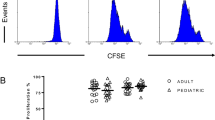Abstract
The objective of this study was to assess the validity of the lymphocyte proliferation assay in the diagnosis of Lyme arthritis (LA). We analyzed peripheral blood mononuclear cells of 11 patients with LA and 5 healthy controls for proliferative responses to live Borrelia burgdorferi by 3H-thymidine uptake. Before and after proliferation, the total number of cells was estimated and the relative amount of lymphocyte subsets was determined by FACS. Lymphoproliferative responses to B. burgdorferi in patients with LA were predominantly due to CD4+ cells and in a small part due to CD8+ cells and were antigen-dependent in comparison to healthy donors. Considering the number of cells before proliferation, responses of TCRγ/δ+ cells and CD56+ cells were higher than responses of TCRα/β+ and CD3+ cells in LA patients, but not in healthy donors. There were no demonstrable antigen-dependent CD19+ cell responses. Our results support the validity of lymphocyte proliferation assay in the diagnosis of LA.
Similar content being viewed by others
Author information
Authors and Affiliations
Additional information
Received: 28 May 1997 / Accepted: 20 September 1997
Rights and permissions
About this article
Cite this article
Rutkowski, S., Busch, D. & Huppertz, H. Lymphocyte proliferation assay in response to Borrelia burgdorferi in patients with Lyme arthritis: analysis of lymphocyte subsets. Rheumatology International 17, 151–158 (1997). https://doi.org/10.1007/s002960050027
Issue Date:
DOI: https://doi.org/10.1007/s002960050027




